2021 MERCEDES-BENZ GLE SUV ABS
[x] Cancel search: ABSPage 14 of 545
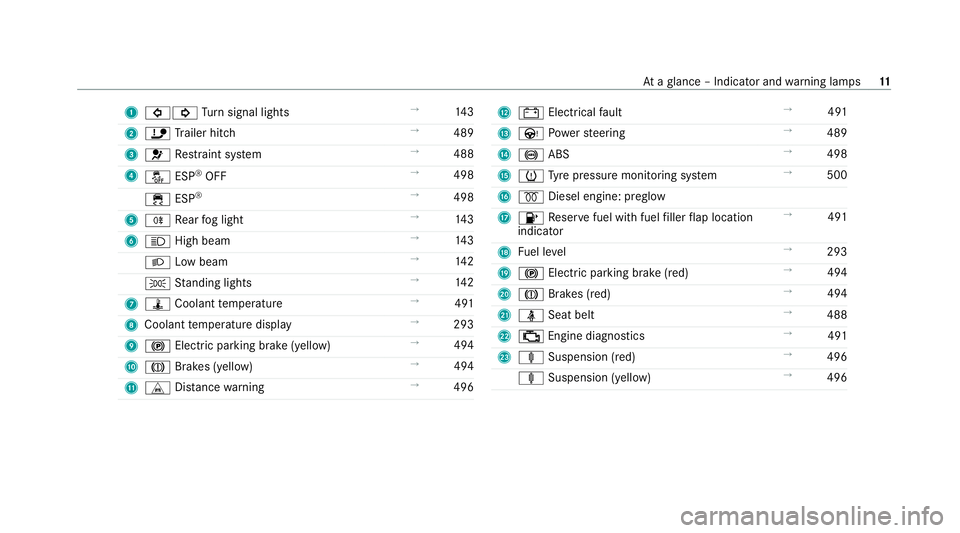
1
003E003D Turn signal lights →
14 3
2 ï Trailer hit ch →
489
3 0075 Restra int sy stem →
488
4 00BB ESP®
OFF →
498
00E5 ESP®
→
498
5 005E Rear fog light →
14 3
6 0057 High beam →
14 3
0058 Low beam →
14 2
0060 Standing lights →
14 2
7 ÿ Coolant temp erature →
491
8 Coolant temp erature display →
293
9 0024 Electric pa rking brake (yellow) →
494
A 004D Brakes (yellow) →
494
B L Distance warning →
496 C
003D Electrical fault →
491
D Ù Powe rst eering →
489
E 0025 ABS →
498
F 0077 Tyre pressure monitoring sy stem →
500
G 0028 Diesel engine: preglow
H 00B6 Reser vefuel with fuel filler flap location
indicator →
491
I Fuel le vel →
293
J 0024 Electric parking brake (red) →
494
K 004D Brakes (red) →
494
L 00E9 Seat belt →
488
M 00B9 Engine diagnostics →
491
N ä Suspension (red) →
496
ä Suspension (yell ow) →
496 At
aglance – Indicator and warning lamps 11
Page 28 of 545
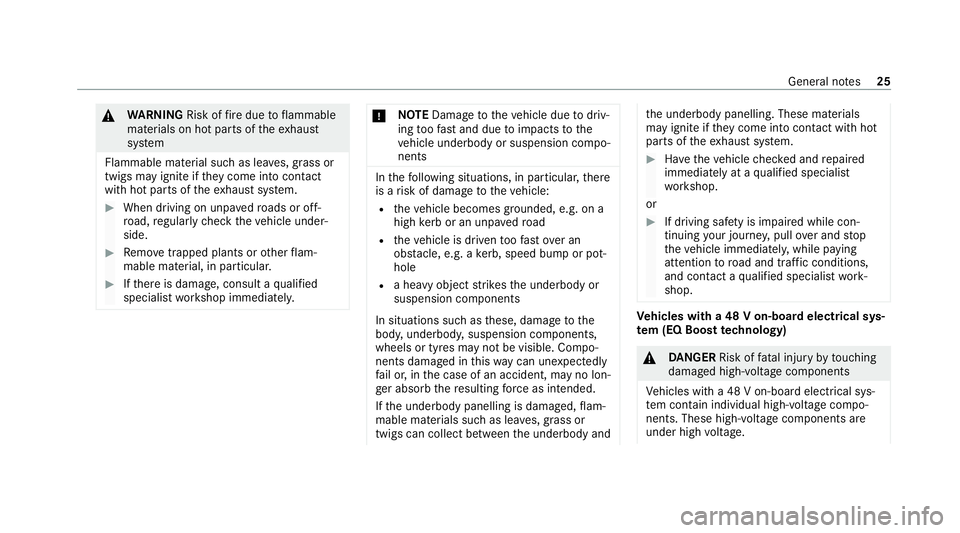
&
WARNING Risk offire due toflammable
materials on hot parts of theex haust
sy stem
Flammable material such as lea ves, grass or
twigs may ignite if they come into contact
wi th hot parts of theex haust sy stem. #
When driving on unpa vedro ads or off-
ro ad, regular lych eck theve hicle under‐
side. #
Remo vetrapped plants or other flam‐
mable material, in particular. #
Ifth ere is damage, consult a qualified
specialist workshop immediately. *
NO
TEDama getotheve hicle due todriv‐
ing toofast and due toimpacts tothe
ve hicle underbody or suspension compo‐
nents In
thefo llowing situations, in particular, there
is a risk of damage totheve hicle:
R theve hicle becomes grounded, e.g. on a
high kerb or an unpa vedro ad
R theve hicle is driven toofast over an
obs tacle, e.g. a kerb, speed bump or pot‐
hole
R a heavy object strike sth e underbody or
suspension components
In situations such as these, damage tothe
body, underbody, suspension components,
wheels or tyres may not be visible. Compo‐
nents damaged in this wa y can unexpecte dly
fa il or, in the case of an accident, may no lon‐
ge r absorb there sulting forc e as intended.
If th e underbody panelling is damaged, flam‐
mable materials such as lea ves, grass or
twigs can collect between the underbody and th
e underbody panelling. These materials
may ignite if they come into contact wi thhot
parts of theex haust sy stem. #
Have theve hicle checked and repaired
immediately at a qualified specialist
wo rkshop.
or #
If driving saf ety is impaired while con‐
tinuing your journe y,pull over and stop
th eve hicle immediatel y,while paying
attention toroad and traf fic conditions,
and contact a qualified specialist work‐
shop. Ve
hicles with a 48 V on-board electrical sys‐
te m (EQ Boo sttech nology) &
DANG ER Risk of fata l injury bytouching
damaged high-voltage co mponents
Ve hicles with a 48 V on-board electrical sys‐
te m contain individual high-voltage compo‐
nents. These high-voltage components are
under high voltage. General no
tes25
Page 32 of 545
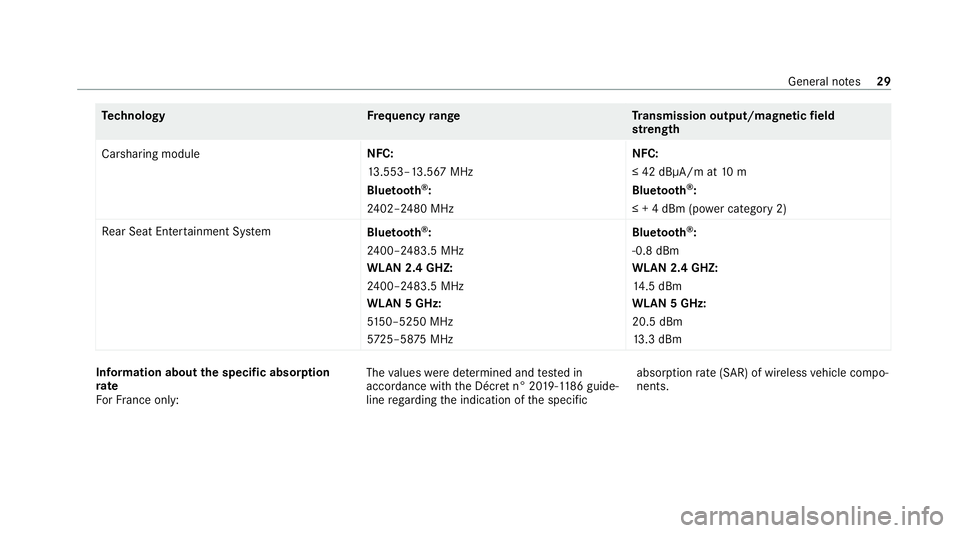
Te
ch nology Frequency rang eT ransmission output/magnetic field
st re ngth
Carsharing module NFC:
13
.553–13.567 MHz
Blue tooth ®
:
24 02–2480 MHz NFC:
≤ 42 dBμA/m at
10 m
Blue tooth ®
:
≤ + 4 dBm (p ower category 2)
Re ar Seat Ente rtainment Sy stem
Bluetooth ®
:
24 00–2483.5 MHz
WLAN 2.4 GHZ:
24 00–2483.5 MHz
WLAN 5 GHz:
51 50–5250 MHz
572 5–58 75MHz Blue
tooth ®
:
-0.8 dBm
WLAN 2.4 GHZ:
14 .5 dBm
WLAN 5 GHz:
20.5 dBm
13 .3 dBm In
fo rm ation about the specific absor ption
rate
Fo rFr ance on ly: The
values weredeterm ined and tested in
accordance with the Décre t n° 2019-118 6guide‐
line rega rding the indication of the specific absor
ption rate (SAR) of wireless vehicle compo‐
nents. General no
tes29
Page 33 of 545
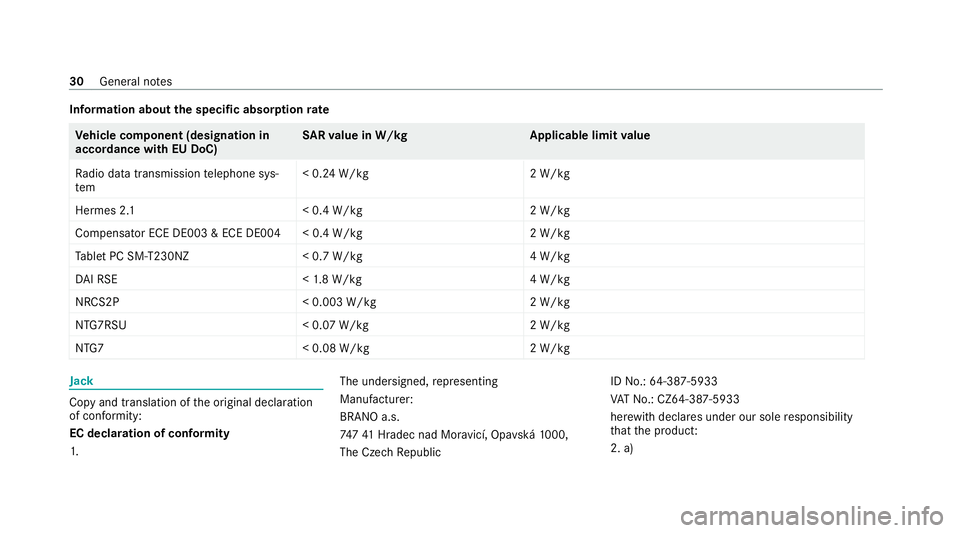
Information about
the specific absor ption rate Ve
hicle comp onent (designation in
accordance with EU DoC) SA
Rva lue in W/k gA pplicable limitvalue
Ra dio data transmission telephone sys‐
tem < 0.24 W/k
g2 W/kg
Hermes 2. 1< 0.4 W/kg2 W/kg
Compensator ECE DE003 & ECE DE004 < 0.4 W/k g2W/kg
Ta blet PC SM-T230NZ < 0.7 W/kg4 W/kg
DA I RSE <1.8 W/k g4 W/kg
NRCS2P < 0.003 W/kg2 W/kg
NTG7RSU < 0.07 W/kg2 W/kg
NTG7 < 0.08 W/kg2 W/kgJack
Copy and translation of
the original declaration
of confo rmity:
EC declaration of conformity
1. The undersigned,
representing
Manufacturer:
BRANO a.s.
74 741 Hradec nad Mor avicí, Opa vská 1000,
The Czech Republic ID No.:
64-387-5933
VA T No.: CZ64-387 -5933
her ewith declares under our sole responsibility
th at the product:
2. a) 30
General no tes
Page 71 of 545
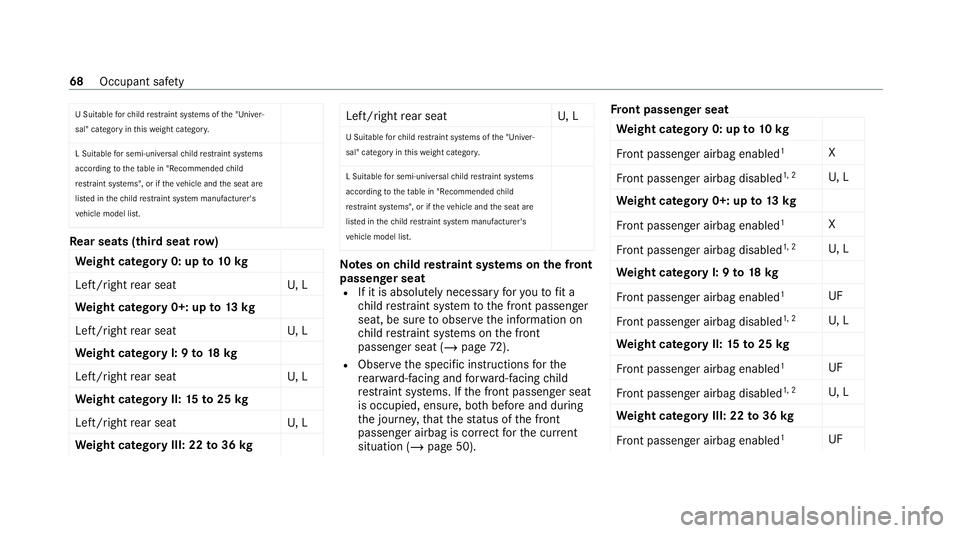
U Suitable
forch ild restra int sy stems of the "Univer‐
sal" category in this we ight categor y.
L Suitable for semi-universal child restra int sy stems
according totheta ble in "Recommended child
re stra int sy stems", or if theve hicle and the seat are
lis ted in thech ild restrai nt sy stem manufacturer's
ve hicle model list. Re
ar seats (third seat row)
We ight category 0: up to10 kg
Left/right rear seat U, L
We ight category 0+: up to13 kg
Left/right rear seat U, L
We ight category I: 9 to18 kg
Left/right rear seat U, L
We ight category II: 15to25 kg
Left/right rear seat U, L
We ight category III: 22 to36 kg Left/right
rear seat U, L
U Suitable forch ild restra int sy stems of the "Univer‐
sal" category in this we ight categor y.
L Suitable for semi-universal child restrai nt sy stems
according totheta ble in "Recommended child
re strai nt sy stems", or if theve hicle and the seat are
lis ted in thech ild restra int sy stem manufacturer's
ve hicle model list. Note
s onchild restra int sy stems on the front
passenger seat
R If it is absolutely necessary foryo uto fit a
ch ild restra int sy stem tothe front passenger
seat, be sure toobser vethe information on
ch ild restra int sy stems on the front
passenger seat (/ page72).
R Obser vethe specific instructions forthe
re ar wa rd-facing and forw ard-facing child
re stra int sy stems. If the front passenger seat
is occupied, ensure, bo thbefore and during
th e journe y,that thest atus of the front
passenger airbag is cor rect forth e cur rent
situation (/ page 50). Fr
ont passenger seat
We ight category 0: up to10 kg
Fr ont passenger airbag enabled 1
X
Fr ont passenger airbag disabled 1, 2
U, L
We ight category 0+: up to13 kg
Fr ont passenger airbag enabled 1
X
Fr ont passenger airbag disabled 1, 2
U, L
We ight category I: 9 to18 kg
Fr ont passenger airbag enabled 1
UF
Fr ont passenger airbag disabled 1, 2
U, L
We ight category II: 15to25 kg
Fr ont passenger airbag enabled 1
UF
Fr ont passenger airbag disabled 1, 2
U, L
We ight category III: 22 to36 kg
Fr ont passenger airbag enabled 1
UF 68
Occupant saf ety
Page 74 of 545
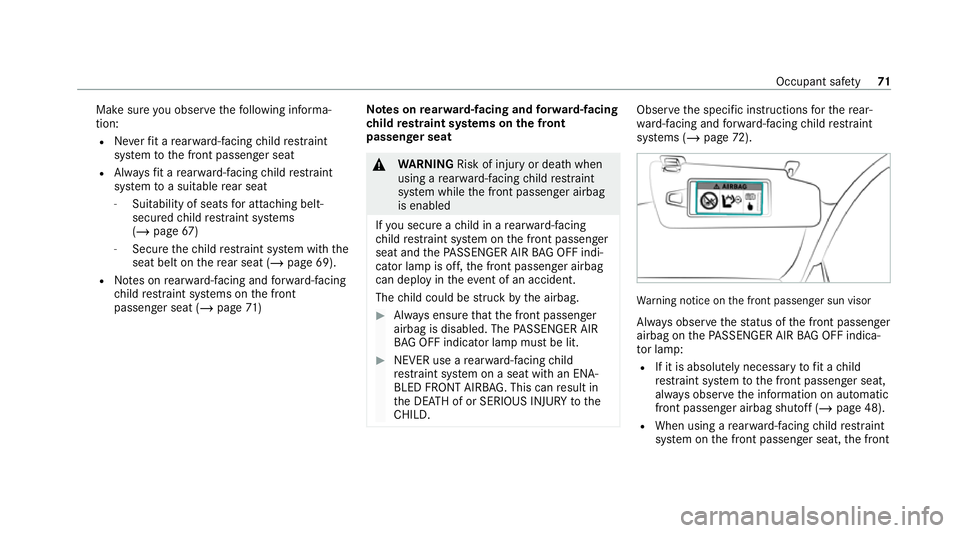
Make sure
you obse rveth efo llowing informa‐
tion:
R Neverfit a rear wa rd-facing child restra int
sy stem tothe front passenger seat
R Alw aysfit a rear wa rd-facing child restra int
sy stem toa suitable rear seat
- Suitability of seats for attaching belt-
secured child restra int sy stems
(/ page 67 )
- Secu rethech ild restra int sy stem with the
seat belt on there ar seat (/ page 69).
R Notes on rear wa rd-facing and forw ard-facing
ch ild restra int sy stems on the front
passenger seat (/ page71 ) Note
s onrear wa rd-facing and forw ard-facing
ch ild restra int sy stems on the front
passenger seat &
WARNING Risk of injury or death when
using a rear wa rd-facing child restra int
sy stem while the front passenger airbag
is enabled
If yo u secure a child in a rear wa rd-facing
ch ild restra int sy stem on the front passenger
seat and thePA SSENGER AIR BAG OFF indi‐
cator lamp is off, the front passenger airbag
can deploy in theev ent of an accident.
The child could be stru ck bythe airbag. #
Alw ays ensure that the front passenger
airbag is disabled. The PASSENGER AIR
BA G OFF indicator lamp must be lit. #
NEVER use a rear wa rd-facing child
re stra int sy stem on a seat with an ENA‐
BLED FRONT AIRB AG. This can result in
th e DEAT H of or SERIOUS INJURY tothe
CH ILD. Obser
vethe specific instructions forth ere ar‐
wa rd-facing and forw ard-facing child restra int
sy stems (/ page72). Wa
rning notice on the front passenger sun visor
Alw ays obser vethest atus of the front passenger
airbag on thePA SSENGER AIR BAG OFF indica‐
to r lamp:
R If it is absolutely necessary tofit a child
re stra int sy stem tothe front passenger seat,
alw ays obser vethe information on automatic
front passenger airbag shutoff (/ page 48).
R When using a rear wa rd-facing child restra int
sy stem on the front passenger seat, the front Occupant saf
ety71
Page 185 of 545
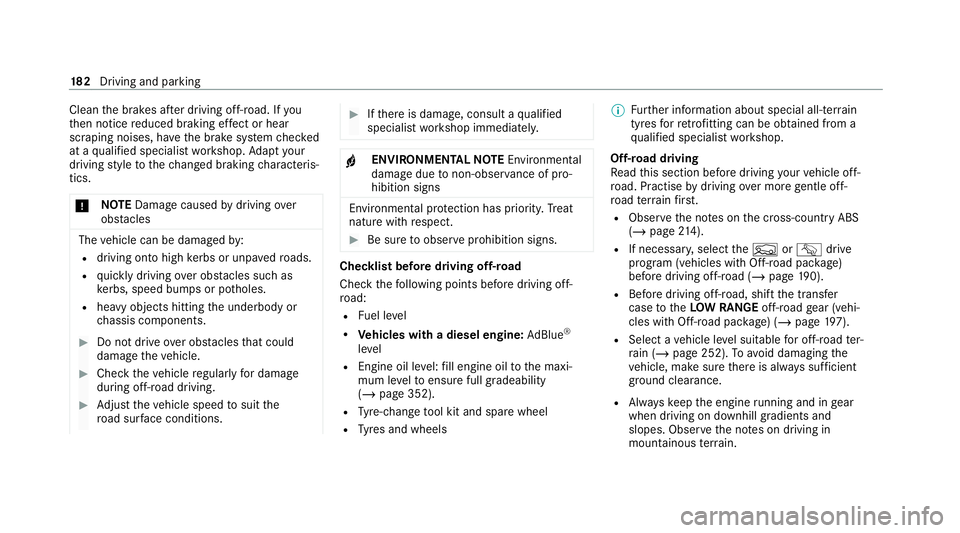
Clean
the brakes af ter driving off-road. If you
th en notice reduced braking ef fect or hear
scraping noises, ha vethe brake sy stem checked
at a qualified specialist workshop. Adapt your
driving style to thech anged braking characteris‐
tics.
* NO
TEDama gecaused bydriving over
obs tacles The
vehicle can be damaged by:
R driving onto high kerbs or unpa vedro ads.
R quickly driving over obs tacles su chas
ke rbs, speed bumps or po tholes.
R heavy objects hitting the underbody or
ch assis components. #
Do not drive over obs tacles that could
damage theve hicle. #
Check theve hicle regular lyfor dama ge
during off-road driving. #
Adjust theve hicle speed tosuit the
ro ad sur face conditions. #
Ifth ere is damage, consult a qualified
specialist workshop immediately. +
ENVIRONMENTAL
NOTEEnvironmental
dama gedue tonon-obser vance of pro‐
hibition signs Environmental pr
otection has priority. Treat
nature with respect. #
Be sure toobser veprohibition signs. Checklist before driving off-road
Check
thefo llowing points before driving off-
ro ad:
R Fuel le vel
R Vehicles with a diesel engine: AdBlue ®
le vel
R Engine oil le vel:fill engine oil tothe maxi‐
mum le velto ensure full gradeability
(/ page 352).
R Tyre-change tool kit and spare wheel
R Tyres and wheels %
Further information about special all-ter rain
tyres forre trofitting can be ob tained from a
qu alified specialist workshop.
Off-road driving
Re ad this section before driving your vehicle off-
ro ad. Practise bydriving over more gentle off-
ro ad terrain firs t.
R Obse rveth e no tes on the cross-country ABS
(/ page 214).
R Ifnecessa ry, select theF orG drive
program (vehicles with Off-road pac kage)
before driving off-road (/ page190).
R Before driving off-road, shift the transfer
case totheLO W RANGE off-roadgear (vehi‐
cles with Off- road pac kage ) (/ page 197).
R Select a vehicle le vel suitable for off-road ter‐
ra in (/ page 252). Toavo id damaging the
ve hicle, make sure there is alw ays suf ficient
ground clearance.
R Alw ayske ep the engine running and in gear
when driving on downhill gradients and
slopes. Obse rveth e no tes on driving in
mountainous terrain. 18 2
Driving and pa rking
Page 199 of 545
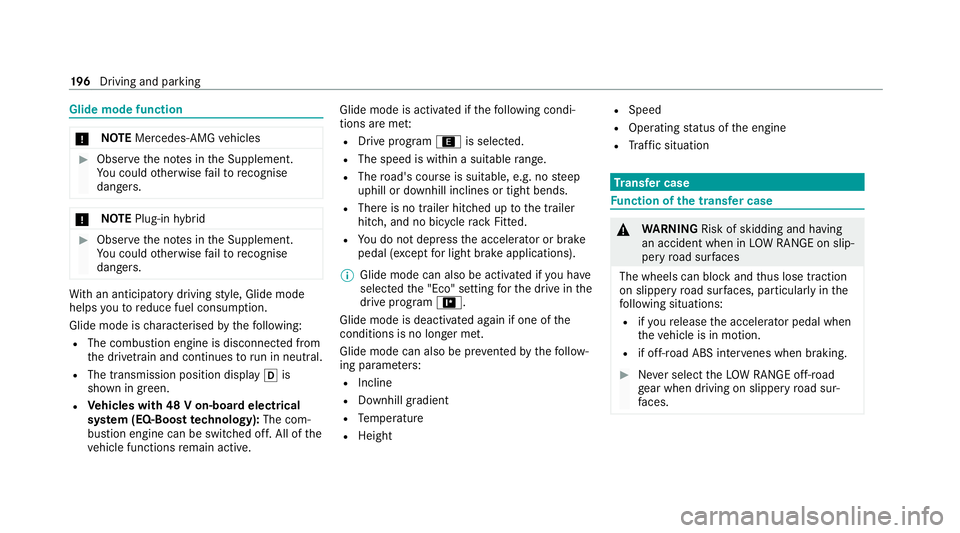
Glide mode function
*
NO
TEMercedes-AMG vehicles #
Obser vethe no tes in the Supplement.
Yo u could otherwise failto recognise
dangers. *
NO
TEPlug-in hybrid #
Obser vethe no tes in the Supplement.
Yo u could otherwise failto recognise
dangers. Wi
th an anticipatory driving style, Glide mode
helps youto reduce fuel consum ption.
Glide mode is characterised bythefo llowing:
R The combustion engine is disconnected from
the driv etra in and continues torun in neutral.
R The transmission position displ ay005B is
shown in green.
R Vehicles with 48 V on-board electrical
sy stem (EQ-Boost technology): The com‐
bustion engine can be switched off. All of the
ve hicle functions remain active. Glide mode is activated if
thefo llowing condi‐
tions are me t:
R Drive prog ram ; is selected.
R The speed is within a suitable range.
R The road's course is suitable, e.g. no steep
uphill or downhill inclines or tight bends.
R There is no trailer hitched up tothe trailer
hitch, and no bicycle rack Fitted.
R You do not depress the accelera tor or brake
pedal (e xcept for light brake applications).
% Glide mode can also be activated if you ha ve
selected the "Eco" setting forth e drive in the
drive prog ram =.
Glide mode is deactivated again if one of the
conditions is no longer met.
Glide mode can also be pr evented bythefo llow‐
ing parame ters:
R Incline
R Downhill gradient
R Temp erature
R Height R
Speed
R Operating status of the engine
R Traf fic situation Tr
ansfer case Fu
nction of the transfer case &
WARNING Risk of skidding and having
an accident when in LOW RANGE on slip‐
pery road sur faces
The wheels can block and thus lose traction
on slippery road sur faces, pa rticularly in the
fo llowing situations:
R ifyo ure lease the accelera tor pedal when
th eve hicle is in motion.
R if off-road ABS inter venes when braking. #
Never select theLO W RANGE off-road
ge ar when driving on slippe ryroad sur‐
fa ces. 19 6
Driving and pa rking